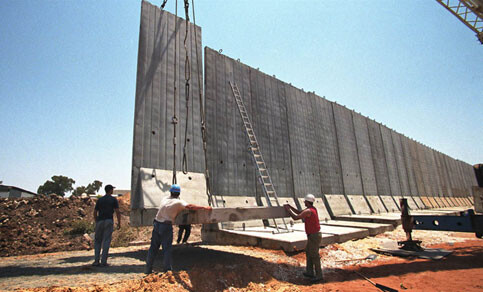United Nations 28 November 2003

Photo: Ronald de Hommel, 2002
The Secretary-General today released his report, requested by the General Assembly, on the Government of Israel’s compliance with the Assembly’s resolution A/ES - 10/13 of 21 October 2003, which demands that Israel stop and reverse construction of a barrier in the occupied Palestinian territory.
The Secretary-General points out that Israel’s right to live in peace and security “should not be carried out in a way that is in contradiction to international law, that could damage the longer-term prospects for peace by making the creation of an independent, viable and contiguous Palestinian State more difficult, or that increases suffering among the Palestinian people”.
The Secretary-General notes Israel’s repeated statements that the barrier is a temporary security measure, which “does not represent a political or other border”. But, he says, the scope of construction and the amount of occupied West Bank land that is either being requisitioned for its route or that will end up between the barrier and the Green Line are of serious concern and have implications for the future. “In the midst of the Road Map process, when each party should be making good faith confidence-building gestures, the barrier’s construction in the West Bank cannot, in this regard, be seen as anything but a deeply counterproductive act. The placing of most of the structure on occupied Palestinian land could impair future negotiations.”
According to the report, much of the completed barrier, excluding East Jerusalem, runs close to the Green Line, though within Palestinian territory except for a short stretch west of Tulkarm. But in places it deviates more than 7.5 kilometres from the Green Line to incorporate settlements, while encircling Palestinian areas. And the planned route, if fully constructed, would deviate up to 22 kilometres in places from the Green Line. If all features of the planned barrier route were constructed, approximately 975 square kilometres, or 16.6 per cent of the entire West Bank, including the homes of some 220,000 Palestinians in East Jerusalem and 17,000 in the rest of the West Bank, would lie between the barrier and the Green Line, while a further 160,000 Palestinians would live in enclaves almost completely encircled by the barrier. This planned route also places 320,000 Israeli settlers between the barrier and the Green Line, including some 178,000 in occupied East Jerusalem.
In addition to reporting on Israel’s compliance with the resolution, the Secretary-General informs the General Assembly about the humanitarian and socio-economic impact of completed barrier sections, and the implications of the official planned route. His findings include the following:
— Approximately 56,000 Palestinians already live in enclaves created by the barrier, most notably the town of Qalqiliya, in which access to land, markets, jobs and services is seriously harmed.
— Among these 56,000 Palestinians, around 5,300 live in special zones between the barrier and the Green Line which are under new military orders and require permits for residence.
— The barrier appears likely to deepen the fragmentation of the West Bank created by the closure system Israel imposed after the outbreak of hostilities in October 2000 - a series of checkpoints and blockades that severely restrict the movement of Palestinian people and goods, causing serious socio-economic harm.
— Recent reports by the World Bank and United Nations show that barrier construction has dramatically increased such damage in communities along its route, primarily through the loss of, or severely limited access to, land, jobs and markets.
The Secretary-General remains convinced that the only outcome that will bring lasting security and prosperity to both sides is a just, durable and comprehensive peace in the Middle East in which two sovereign and independent States, Israel and Palestine, live side by side within secure and recognized borders, consistent with United Nations Security Council resolution 242, 338, 1397 and 1515. He urges the Government of Israel and the Palestinian Authority to go back to the negotiating table to reach this end.
To download the full report click here.